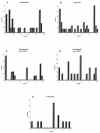Characterization of antibody responses to Wolbachia surface protein in humans with lymphatic filariasis
- PMID: 12933853
- PMCID: PMC187306
- DOI: 10.1128/IAI.71.9.5104-5114.2003
Characterization of antibody responses to Wolbachia surface protein in humans with lymphatic filariasis
Abstract
Symbiotic Wolbachia organisms of filarial nematodes have received much attention as possible chemotherapy targets and disease-causing organisms. In order to further investigate the association between anti-Wolbachia immune responses and chronic filarial disease in humans, antibody responses to Wolbachia surface protein (WSP) were assayed in serum samples collected from 232 individuals living in Leogane, Haiti, an area where Wuchereria bancrofti infection is endemic, and from 67 North Americans with no history of lymphatic filariasis. As opposed to antifilarial antibody responses, which were largely influenced by the patient's infection status, the prevalence and levels of anti-WSP immunoglobulin G (IgG) antibodies among individuals with lymphedema or hydrocele were significantly greater than those in gender- and infection-matched individuals without disease. In at least one case, the anti-WSP IgG response was coincident with the onset of lymphedema development, and among anti-WSP-positive women with lymphedema, anti-WSP IgG levels were negatively correlated with the duration of lymphedema. The presence of anti-WSP IgG was also associated with the severity of inguinal adenopathy among men with hydrocele. In addition to the presence of anti-WSP antibodies among Haitians, 15 of 67 (22%) serum samples collected from individuals from North America, where filariasis is not endemic, were also positive for anti-WSP antibodies. In comparison to those from Haitians, anti-WSP antibodies from North Americans primarily recognized a distinct region of WSP located within the highly conserved second transmembrane domain. The results of this study demonstrate that anti-WSP antibody responses are associated with the presence of chronic filarial morbidity and not filarial infection status in humans and suggest that WSP should be further studied as a potential trigger for the development of filarial disease.
Figures





References
-
- Addiss, D. G., K. A. Dimock, M. L. Eberhard, and P. J. Lammie. 1995. Clinical, parasitologic, and immunologic observations of patients with hydrocele and elephantiasis in an area with endemic lymphatic filariasis. J Infect. Dis. 171:755-758. - PubMed
-
- Baird, J. B., J. L. Charles, T. G. Streit, J. M. Roberts, D. G. Addiss, and P. J. Lammie. 2002. Reactivity to bacterial, fungal, and parasite antigens in patients with lymphedema and elephantiasis. Am. J. Trop. Med. Hyg. 66:163-169. - PubMed
-
- Bandi, C., J. W. McCall, C. Genchi, S. Corona, L. Venco, and L. Sacchi. 1999. Effects of tetracycline on the filarial worms Brugia pahangi and Dirofilaria immitis and their bacterial endosymbionts Wolbachia. Int. J. Parasitol. 29:357-364. - PubMed
-
- Bazzocchi, C., W. Jamnongluk, S. L. O'Neill, T. J. Anderson, C. Genchi, and C. Bandi. 2000. wsp gene sequences from the Wolbachia of filarial nematodes. Curr. Microbiol. 41:96-100. - PubMed
Publication types
MeSH terms
Substances
LinkOut - more resources
Full Text Sources
Other Literature Sources
Research Materials

